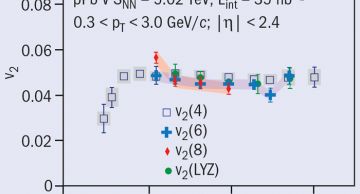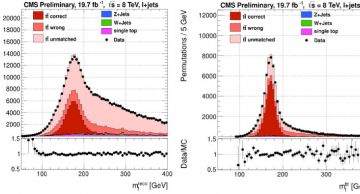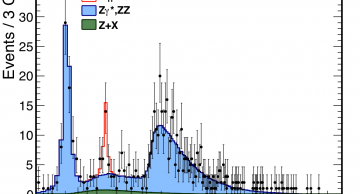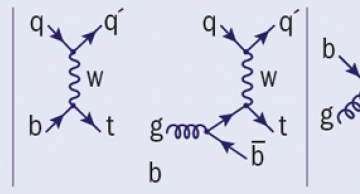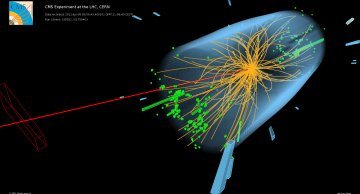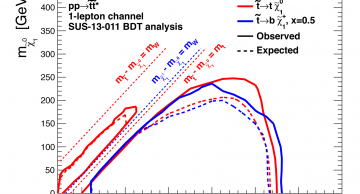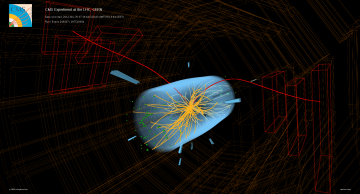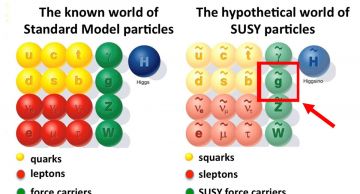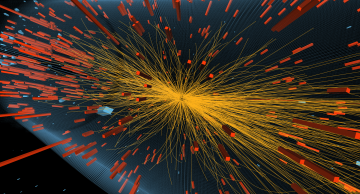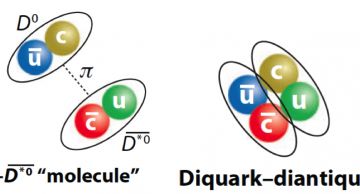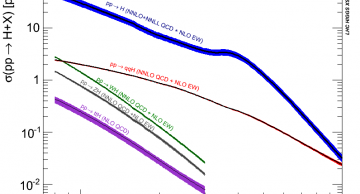This article originally appeared in the CERN Courier on 22 May 2014.
Although the CMS experiment was designed primarily for precise measurements in proton–proton (pp) collisions, in recent years it has demonstrated exceptional capabilities in…
News
|
Anonymous |
Physics
The new top-quark mass measurement is the single most precise result as yet.
The mass of the top quark, the heaviest known elementary particle to-date, is one of the fundamental parameters of the Standard Model. Although the top quark mass is…
|
Anonymous |
Physics
CMS has improved the constraints on the Higgs width, a fundamental property of this unique new particle, by more than two orders of magnitude.
Nearly two years after its discovery, there is much to learn about the Higgs boson observed by the CMS and…
|
malgeri |
Physics
In the past two weeks we had the final round of approvals for Moriond EW that is taking place during the week of Mar 17-22. The results approved are:
EXO-12-030: a search for pair-production of third generation scalar leptoquarks decaying to top…
|
achintya |
Physics
The top quark remains, nearly 20 years after its discovery by the experiments at Fermilab’s Tevatron, the heaviest particle known. Its production and decays continue to be the subjects of extensive studies, both at the Tevatron and at the LHC. While…
|
achintya |
Physics
At a seminar held at CERN this morning, the CMS collaboration presented several measurements of the properties of the Higgs boson discovered in July 2012. CMS showed for the first time strong evidence for the decay of Higgs bosons into fermions,…
|
vimartin |
Physics
CMS presented new results of searches for signatures of supersymmetry (SUSY) at the LHCP conference held in Barcelona, Spain in May and at the EPSHEP conference held in Stockholm, Sweden in July. These results use either the full 20 fb–1 of data…
|
achintya |
Physics
CMS Experiment, CERN
25 July 2013
UPDATE: Last Friday, CMS and LHCb reported their individual results for the decay of Bs mesons into pairs of muons (see CMS results below). Yesterday, both collaborations jointly presented a preliminary combination…
|
lincoln |
Physics
One of the biggest unanswered questions of particle physics is why the mass of the Higgs boson is relatively small when the Standard Model suggests a more natural value would be many thousands of trillions of times higher. We don't know the answer…
|
velkovsk |
Physics
Observing a phenomenon for the first time helps us fine-tune our understanding of the Universe. CMS physicists found such a phenomenon in September 2012 in proton-lead collisions, an observation that has since been reinforced by much more data from…
|
fanfani |
Physics
CMS measures production rates up to high transverse momenta
A decade after its unexpected discovery, the properties of the X(3872) exotic resonance are still under intense scrutiny. This state was first seen in 2003 by the Belle experiment and then…
|
pivarski |
Physics
Sometimes, everyday words are co-opted by scientists and used as technical terms. One of these is the word “berry”. Talking to a botanist friend of mine, I learned that tomatoes are berries, but strawberries are not — the scientific meaning of a…

